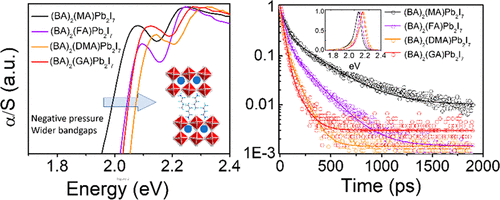当前位置:
X-MOL 学术
›
J. Am. Chem. Soc.
›
论文详情
Our official English website, www.x-mol.net, welcomes your
feedback! (Note: you will need to create a separate account there.)
Negative Pressure Engineering with Large Cage Cations in 2D Halide Perovskites Causes Lattice Softening
Journal of the American Chemical Society ( IF 14.4 ) Pub Date : 2020-06-03 , DOI: 10.1021/jacs.0c03860 Xiaotong Li 1 , Yongping Fu 1 , Laurent Pedesseau 2 , Peijun Guo 3 , Shelby Cuthriell 1 , Ido Hadar 1 , Jacky Even 2 , Claudine Katan 4 , Constantinos C Stoumpos 5 , Richard D Schaller 1, 3 , Elad Harel 6 , Mercouri G Kanatzidis 1
Journal of the American Chemical Society ( IF 14.4 ) Pub Date : 2020-06-03 , DOI: 10.1021/jacs.0c03860 Xiaotong Li 1 , Yongping Fu 1 , Laurent Pedesseau 2 , Peijun Guo 3 , Shelby Cuthriell 1 , Ido Hadar 1 , Jacky Even 2 , Claudine Katan 4 , Constantinos C Stoumpos 5 , Richard D Schaller 1, 3 , Elad Harel 6 , Mercouri G Kanatzidis 1
Affiliation

|
Organic-inorganic hybrid halide perovskites are promising semiconductors with tailorable optical and electronic properties. The choice of A-site cation to support a three-dimensional (3D) perovskite structure AMX3 (where M is a metal, and X is a halide) is limited by the geometric Goldschmidt tolerance factor. However, this geometric constraint can be relaxed in two-dimensional (2D) perovskites, providing us an opportunity to understand how various the A-site cations modulate the structural properties and thereby the optoelectronic properties. Here, we report the synthesis and structures of single-crystals (BA)2(A)Pb2I7 where BA = butylammonium, and A = methylammonium (MA), formamidinium (FA), dimethylammonium (DMA) or guanidinium (GA), a series of A-site cation varied in size. Single-crystal X-ray diffraction reveals that the MA, FA, and GA structures crystallize in the same Cmcm space group, while the DMA imposes the Ccmb space group. We observe that as the A-site cation becomes larger, the Pb-I bond continuously elongates, expanding the volume of the perovskite cage, equivalent to exerting "negative pressure" on the perovskite structures. Optical studies and DFT calculations show the Pb-I bond length elongation reduces overlap of the Pb s- and I p-orbitals and increases the optical bandgap, while Pb-I-Pb angles play a secondary role. Raman spectra show lattice softening with increasing size of the A-site cation. These structural changes with enlarged A cations result in significant decreases in photoluminescence intensity and lifetime, consistent with a more pronounced nonradiative decay. Transient absorption microscopy (TAM) results suggest that the PL drop may derive from a higher concentration of traps or phonon-assisted nonradiative recombination. The results highlight that extending the range of Goldschmidt tolerance factors for 2D perovskites is achievable, enabling further tuning of the structure-property relationships in 2D perovskites.
中文翻译:

二维卤化物钙钛矿中大笼阳离子的负压工程导致晶格软化
有机-无机杂化卤化物钙钛矿是具有可定制光学和电子特性的有前途的半导体。选择 A 位阳离子来支持三维 (3D) 钙钛矿结构 AMX3(其中 M 是金属,X 是卤化物)受到几何 Goldschmidt 容差因子的限制。然而,这种几何约束可以在二维 (2D) 钙钛矿中放松,让我们有机会了解各种 A 位阳离子如何调节结构特性,从而调节光电特性。在这里,我们报告了单晶 (BA)2(A)Pb2I7 的合成和结构,其中 BA = 丁基铵,A = 甲基铵 (MA)、甲脒 (FA)、二甲基铵 (DMA) 或胍 (GA),一系列A 位阳离子的大小各不相同。单晶 X 射线衍射表明 MA、FA、和 GA 结构在相同的 Cmcm 空间群中结晶,而 DMA 强加 Ccmb 空间群。我们观察到,随着 A 位阳离子变大,Pb-I 键不断拉长,钙钛矿笼的体积扩大,相当于对钙钛矿结构施加“负压”。光学研究和 DFT 计算表明,Pb-I 键长伸长减少了 Pb s-和 I p-轨道的重叠并增加了光学带隙,而 Pb-I-Pb 角起次要作用。拉曼光谱显示随着 A 位阳离子尺寸的增加晶格软化。这些随着 A 阳离子增大的结构变化导致光致发光强度和寿命显着降低,与更明显的非辐射衰减一致。瞬态吸收显微镜 (TAM) 结果表明 PL 下降可能来自更高浓度的陷阱或声子辅助的非辐射复合。结果强调,扩展二维钙钛矿的 Goldschmidt 容差因子范围是可以实现的,从而能够进一步调整二维钙钛矿的结构-性能关系。
更新日期:2020-06-03
中文翻译:

二维卤化物钙钛矿中大笼阳离子的负压工程导致晶格软化
有机-无机杂化卤化物钙钛矿是具有可定制光学和电子特性的有前途的半导体。选择 A 位阳离子来支持三维 (3D) 钙钛矿结构 AMX3(其中 M 是金属,X 是卤化物)受到几何 Goldschmidt 容差因子的限制。然而,这种几何约束可以在二维 (2D) 钙钛矿中放松,让我们有机会了解各种 A 位阳离子如何调节结构特性,从而调节光电特性。在这里,我们报告了单晶 (BA)2(A)Pb2I7 的合成和结构,其中 BA = 丁基铵,A = 甲基铵 (MA)、甲脒 (FA)、二甲基铵 (DMA) 或胍 (GA),一系列A 位阳离子的大小各不相同。单晶 X 射线衍射表明 MA、FA、和 GA 结构在相同的 Cmcm 空间群中结晶,而 DMA 强加 Ccmb 空间群。我们观察到,随着 A 位阳离子变大,Pb-I 键不断拉长,钙钛矿笼的体积扩大,相当于对钙钛矿结构施加“负压”。光学研究和 DFT 计算表明,Pb-I 键长伸长减少了 Pb s-和 I p-轨道的重叠并增加了光学带隙,而 Pb-I-Pb 角起次要作用。拉曼光谱显示随着 A 位阳离子尺寸的增加晶格软化。这些随着 A 阳离子增大的结构变化导致光致发光强度和寿命显着降低,与更明显的非辐射衰减一致。瞬态吸收显微镜 (TAM) 结果表明 PL 下降可能来自更高浓度的陷阱或声子辅助的非辐射复合。结果强调,扩展二维钙钛矿的 Goldschmidt 容差因子范围是可以实现的,从而能够进一步调整二维钙钛矿的结构-性能关系。









































 京公网安备 11010802027423号
京公网安备 11010802027423号